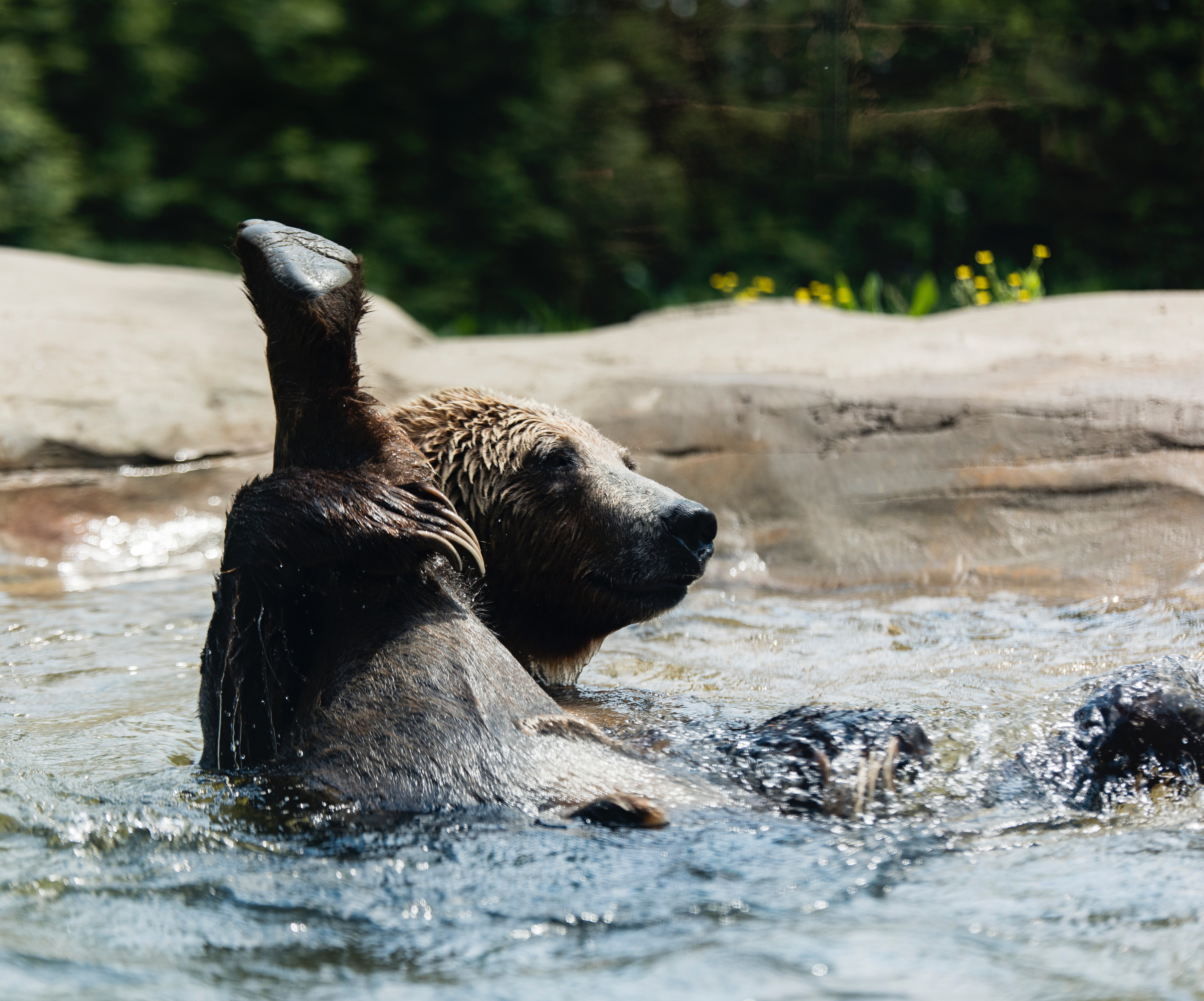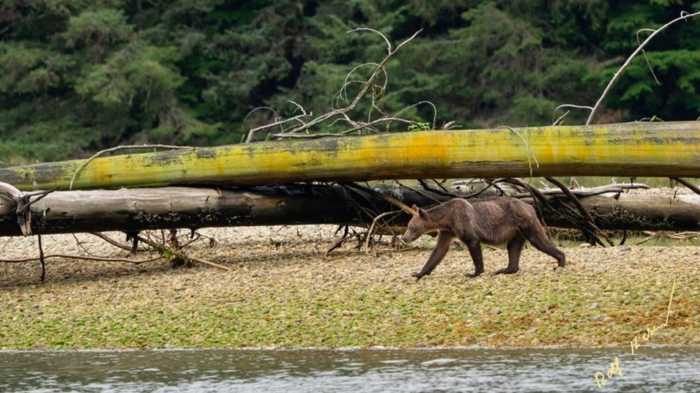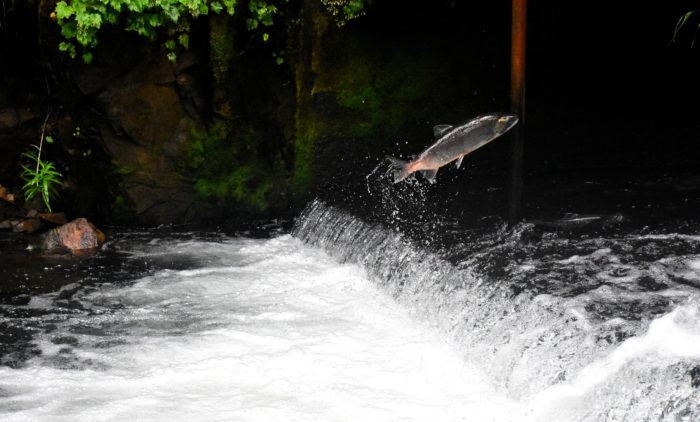If I could sum up my environmental-science education in three words, it would be this: everything is connected. The natural world is more conjoined than we’ll ever know; ecologists are constantly learning about the unforeseen associations between one species and the next, and human-led environmental destruction has (unfortunately) shed even more light on the complex relationships that define ecosystems.
To name just one example, scientists reintroducing wolves in Yellowstone National Park found that, amazingly, the wolves were able to change the ecosystem beyond just the populations of expected species: they actually changed the geology of a river. Such is nature: we don’t even know how integral a particular organism is until it’s gone. This simple fact makes environmental crises like climate change and overfishing all the more scary, because we can’t even predict how far-reaching the effects will be.

Salmon are a primary food source for the grizzly bear.
The dwindling population of salmon in Puget Sound illustrates this point. Salmon are a keystone species: they provide food to a number of predators including grizzlies, bald eagles, and killer whales. They are regarded as an indicator species that scientists can use to gauge the overall health of the ecosystem, and they transfer nutrients between the Pacific Ocean and freshwater habitats. They are an important part of cultural identity to a number of Native-American tribes.
The EPA notes that Chinook salmon (the largest salmon species in Puget Sound) populations have decreased by 60% since tracking began in 1984. Sixteen species of West Coast salmon were listed as endangered or threatened species under the Endangered Species Act in 2005, but their populations have continued to dwindle. Given the importance of salmon to a healthy ecosystem—not to mention the fishes’ right to exist for their own sake—salmon decline is an issue we should all be concerned about.
How salmon decline is affecting other species
Nothing in nature happens in a vacuum. Salmon decline has far-reaching consequences that scientists are still trying to measure and understand. One impact we can point to with certainty, though, is the decline of grizzly bears.
Salmon are the primary food source for grizzly bears. Salmon population size has long been thought to be the primary limiting factor for grizzly populations, and the grizzly population density of salmon-rich areas is 10-20 times higher than in areas where salmon is scarce. Salmon consumption has even been linked to larger brains in male grizzlies and earlier reproductive maturity (and increase in the number of offspring) for female grizzlies. Drawing a parallel to the salmon population, grizzly bears, too, are at a fraction of their historic numbers: to just 1,200-1,400, down from 50,000 strong two centuries ago (2.4%). They’re also listed as a threatened species under the Endangered Species Act. Earlier this month, a wildlife photographer Rolf Hicker’s shots of emaciated grizzly and her two cubs looking for salmon in Knight Inlet (British Columbia) made headlines.

This mother bear was spotted looking desperately for food for her cubs. British Columbia is experiencing the lowest salmon population in fifty years.
“These are facts. The pictures I took are from a couple of weeks ago. It’s the Knight Inlet. We can’t wait another three years or four years. Now is a dire situation,” Hicker said to CTV News. Fortunately, a group of volunteers ended up bringing 500 salmon donated by a local fishery to the river banks frequented by these starving grizzlies—but that is just a temporary respite to a problem that is far bigger and more difficult to remedy. According to local fishermen, salmon population in British Columbia is the lowest it has been in over fifty years. A Fisheries and Oceans Canada report states that the country’s climate is warming twice as quickly as the global average. Salmon can only live in fresh, cold water; hotter streams, rivers, and seas has been devastating juveniles and adults alike.
The lack of salmon isn’t just affecting the grizzlies, though. It’s also affecting the health of forest ecosystems in the Pacific Northwest. It turns out that grizzly bears actually fertilize the forests by leaving partially eaten salmon carcasses on the forest floor. Since salmon embark on a unique journey between freshwater and saltwater ecosystems, they carry a number of nutrients that are critical to a healthy habitat. Salmon carcasses are rich in nitrogen and phosphorous, and contribute to the health of coastal forests.
Salmon disappearance is also linked the decline of orcas, a species of killer whale. Orcas are now classified as depleted under the Marine Mammal Protection Act and endangered under the Endangered Species Act. The southern resident orcas that inhabit the waters around Puget Sound, Washington, became the subject of global outcry when one bereaved mother was spotted pushing her calf toward the surface for weeks after its death. The high infant mortality rate is compounded by high miscarriage rate among the orca moms, which is directly linked to malnutrition caused by low Chinook population, according to a 2017 study by Sam Wasser, the director of the Center for Conservation Biology at the University of Washington. The population of these Chinook salmon-eating orcas are now down to just 73 individuals; because their reproductive potential is by now exhausted, they are considered effectively extinct.
Grizzlies and orcas are just a few of the iconic animals affected by salmon decline. Predators of this keystone species include the bald eagle, bass, harbor seal, great blue heron, and shark. The most deadly predator of salmon, though, are humans—by far.
Why the salmon are disappearing
You may have heard salmon marketed as a “health food.” I personally know plenty of environmentalists who avoid eating red meat for the environment, but still think it’s perfectly harmless to eat salmon. I also know a lot of people who actively seek out salmon because of its reputation as a health food. The myths that salmon consumption is: a) harmless to the environment and b) healthy and necessary have led to the massive salmon decline of the past thirty-five years.
While salmon populations have dwindled, U.S. fish consumption is at an all-time high. Salmon is the highest-valued fish in the U.S., with the entire industry valued at $688 million.
Salmon has long been heralded as a health food and important source of omega-3 fatty acids, a perception that has contributed to the overfishing of the species and what ultimately may lead to its extinction (and the extinction of species cited above!) Five species of salmon are classified as “overfished” by the National Oceanic and Atmospheric Administration, and one species is classified as “subject to overfishing.”
You may think that farmed salmon is a “safe” option. But farmed salmon impact wild populations by spreading contagion like salmon lice and interbreeding, which lowers the future generations’ reproductive health and chances of survival. In fact, Monterey Bay Aquarium Seafood Watch says farmed salmon are on the “avoid” list and to choose wild salmon whenever possible—but we all know how that decimates other species that have evolved to survive primarily—in some cases, only—on salmon. The truth is that there is no “sustainable salmon” option.
Not only are they overfished and subject to contamination, salmon have also fallen victim to climate change. Water temperature affects the behavior of salmon more than any other environmental (and non-living) variable; salmon are cold-blooded organisms who require clean, cold, oxygenated water to survive.
Climate change has a direct effect on the livelihood of salmon: as water warms, salmon die. Even just one season of warmer-than-average temperatures can cause a massive decline in salmon survival.
How you can support the salmon
An outcry over the decline of a single keystone species can move the needle in a significant way. Even in the past five years, we have seen public awareness rise over the protection of bees and rhinoceros. It is this level of mobilization that is now the best chance of salmons’ survival.
The first step to supporting the salmon is to stop eating them. There are a number of other delicious, plant-based options to get your protein and Omega-3: scoop up some flax seeds, hemp seeds, and chia seeds, and try vegan sushi if you’re craving the taste of fish. Raise awareness of the issue by starting conversations. Donate or volunteer for organizations like Save Our Wild Salmon who are working to restore healthy salmon populations in our rivers. If you live in regions with native salmon populations, you may even have an option to donate a dollar or two each month with your power bill to ensure that the hydroelectric dams have salmon ladders for swimming upstream. Every little bit counts.
Also by Maille: How I Took 2 Minute Showers Every Day While Living In Cape Town
I Did A Digital Detox Weekend To Stop My Phone Addiction. Here’s What Happened
Get more like this—Subscribe to our daily inspirational newsletter for exclusive content!
__
Photo: Ryan Grewell on Unsplash; Drew Farwell on Unsplash; Rolf Hicker via Facebook





